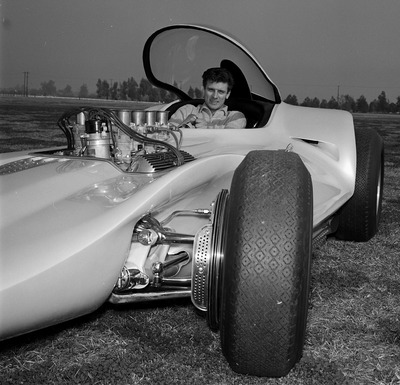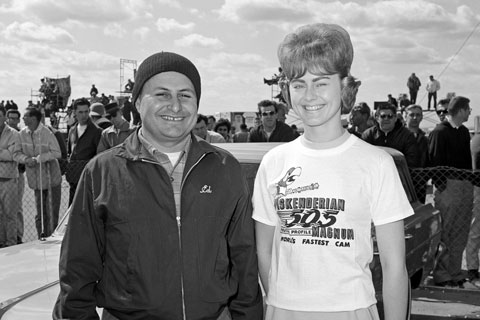HERITAGE
Jeffries’ Turning Point
By Drew Hardin
Photography: Eric Rickman, Petersen Publishing Company Archive
 Throughout much of the ’50s and into the early ’60s, Dean Jeffries earned a reputation as a premier pinstriper, painter and airbrush artist, applying his craft to media as varied as sweatshirts, Indianapolis race cars and James Dean’s infamous “Little Bastard” Porsche. His ambitions went beyond artwork, though. By 1963, he wanted to create an entire custom car, something that would push his career in a whole new direction. Inspiration came from watching sea life on a trip to Seattle, where a manta ray caught his eye.
Throughout much of the ’50s and into the early ’60s, Dean Jeffries earned a reputation as a premier pinstriper, painter and airbrush artist, applying his craft to media as varied as sweatshirts, Indianapolis race cars and James Dean’s infamous “Little Bastard” Porsche. His ambitions went beyond artwork, though. By 1963, he wanted to create an entire custom car, something that would push his career in a whole new direction. Inspiration came from watching sea life on a trip to Seattle, where a manta ray caught his eye.
The foundation for the creation was courtesy of his father-in-law, who had collected two pre-war Maserati Grand Prix race cars and offered them to Jeffries for free if he would remove them from his yard. Eric Rickman’s low-angle front view of the finished product shows off the Maserati’s front suspension components—which Jeffries polished—and its massive, for the era, 15-in. finned brakes behind Goodyear Sports Car Special tires and Halibrand wheels. The Maserati’s quick-change rearend was hung by quarter-elliptical springs, “which have only recently been used in rods,” Rickman wrote in his May 1964 Hot Rod cover story, “Magnificent Mantaray.”
The asymmetrical body Jeffries designed had fenders reminiscent of the sleek sea creature and a single-seat, bubble-top cockpit offset from the car’s centerline. He formed the body from aluminum sheets—not the fiberglass favored by Ed Roth and other custom car builders—hung on a lattice frame of thin steel tubing. According to Tom Cotter’s excellent biography of Jeffries, he carefully joined 86 aluminum panels to make the body look like a single flowing piece and then painted the car in pearlescent white. At car shows, the canopy could be raised and lowered via a radio control system.
It’s hard to see from this angle, but the letters on the engine’s finned valve covers spell “Cobra.” The Weber-carbureted 289 and its four-speed transmission were gifts from Carroll Shelby, repaying Jeffries for painting Shelby’s very first Cobra after it was built in Dean Moon’s shop a year earlier.
Jeffries scratch built the Mantaray in just over three months, working on it nights and weekends after doing body repairs, painting and striping for customers during regular working hours. He debuted the car at the 1964 Oakland Roadster Show, where it won the Tournament of Fame award, a class that promoter Al Slonaker set up for a hand-picked group of custom car builders.
Just before its Oakland debut, the Mantaray made a brief television appearance on “The Steve Allen Show,” which led to its being used in the film Bikini Beach, with Jeffries doing the stunt driving for Frankie Avalon. That role would kick off Jeffries’ decades-long career of building vehicles for movies and TV shows, including the Monkeemobile, the Green Hornet’s Black Beauty, and even a replica of a ’30s street car for Who Framed Roger Rabbit.






